Applicable Products
These instructions apply to the following products:
- Barracuda Intronis Backup - MSP
Rapid Recovery Overview
Rapid Recovery is a restore option that allows you to recover a failed system as a Hyper-V virtual machine in fifteen minutes or less from local storage.
Rapid Recovery is available at no additional cost to any partner who has run an image backup of the source machine’s boot volume.
After you select Rapid Recovery, two recovery settings are displayed:
- Sandboxed test recovery
- Production recovery
Sandboxed Test Recovery
Sandboxed test recovery is useful during tests or demonstrations because a recovery VM that is disconnected from the production network is created. This option ensures the production system’s network connectivity is not interrupted by the test restore.
Production Recovery
Production recovery is used to minimize downtime during a disaster. The recovered VM can be set to connect to a user-defined external virtual switch. This feature ensures that the recovered VM is connected to the appropriate network when powered on.
Managing Rapid Recoveries
After performing a Rapid Recovery, if the Manage Recovery action is not performed, you cannot run a backup/restore for the volumes that were restored using the Rapid Recovery type.
Active Recoveries can be viewed at the Computer’s Active Recoveries page. See Managing an Active Recovery for Production Recovery.
The following table displays the status you can view for each recovery VM.
| Column | What is Displayed |
|---|---|
| VM Name | Recovery VM's name. |
| Host/Location | IP address of the host running the recovery VM. |
| Recovery Mode | Recovery mode (sandboxed test or production). |
| Start Time | Time the Rapid Recovery restore was initiated. |
| Runtime | Uptime of the recovery VM. |
| Actions | Manage Recovery button that allows you to finalize or cancel a recovery. |
Managing an Active Recovery for Production Recovery
To manage an active recovery, perform the following steps.
- At the Computer page, click the Active Recoveries tab, and then click the Manage Recovery button, as shown in the example below.

The Manage Active Recovery page is displayed.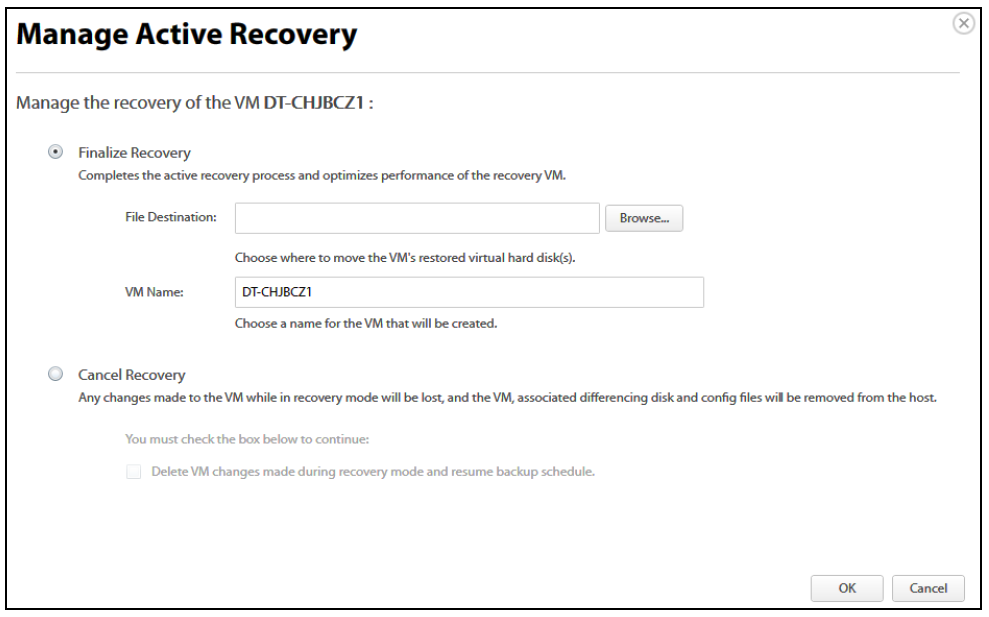
To finalize recovery, click the Finalize Recovery radio button.
Note: The Finalize Recovery option completes the active recovery process and optimizes the performance of the recovery VM. Optionally, click the Browse button, and then select the file destination for the VM’s restored virtual hard disk.
- Optionally, type a name for the VM in the VM Name field.
To cancel the recovery, click the Cancel Recovery radio button.
Note: If the VM was created as a sandboxed test or production recovery, you can cancel the recovery. This action powers off and deletes the recovery VM. Any files created as a part of the test restore are removed from the user-defined location and the recovery VM is deleted from the selected host’s inventory. Ensure the differencing disks are not mounted or in use by any powered-on VM, or the delete operation fails.
Select the Delete VM changes made during recovery mode and resume backup schedule check box.
If enabled, the following occurs:
- Any changes made to this VM or its disks while in recovery mode are lost.
- The differencing disks created during recovery are deleted.
- The recovery VM is powered off and deleted.
- All files created as a part of the test restore are removed from the user-defined location.
- The recovery VM is deleted from the selected host’s inventory.
Managing an Active Recovery for Sandbox Recovery
To manage an active recovery, perform the following steps.
- At the Computer page, click the Active Recoveries tab, and then click the Manage Recovery button, as shown in the example below.

The End test recovery and delete changes page is displayed.
- Ensure the differencing disks are not mounted or in use by any powered-on VM, or the delete operation fails.
- Select the Delete VM changes made during recovery mode and resume backup schedule check box.
If enabled, the following occurs:
- Any changes made to this VM or its disks while in recovery mode are lost.
- The differencing disks created during recovery are deleted.
- The recovery VM is powered off and deleted.
- All files created as a part of the test restore are removed from the user-defined location.
- The recovery VM is deleted from the selected host’s inventory.
Rapid Recovery Restore Tabs

The following table provides a description of the page features.
| Page | Description |
|---|---|
| Select | Select at least one available VM to restore |
| Destination | Choose where the data is restored. Select how to verify and recover your data to the restore destination.
|
| Summary | A list of your selections is displayed. |
Rapid Recovery Restore
To restore using Rapid Recovery, perform the following steps.
- Navigate to the Computer page.
The Computer Page is displayed.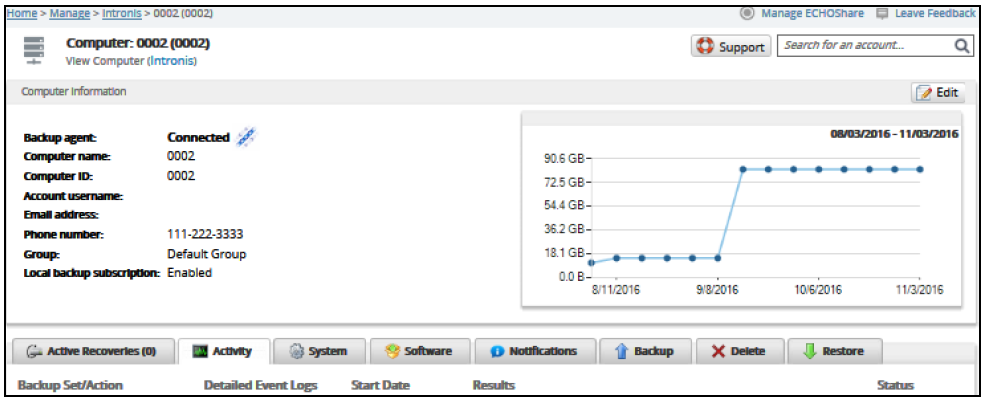
- Click the Restore tab.
The Restore Selections page is displayed.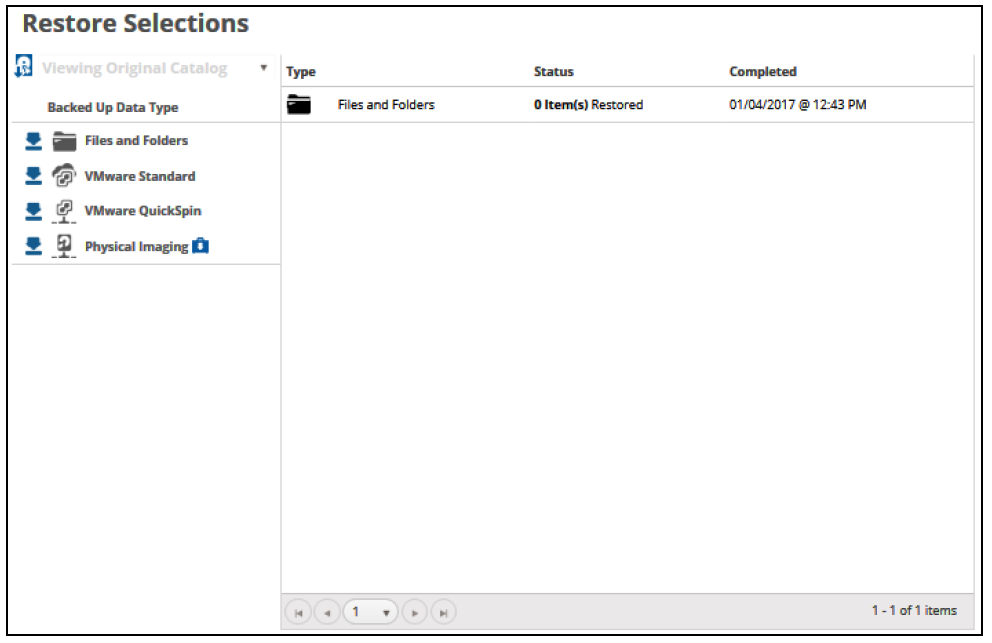
- Click the restore
 icon of the backup type you want to restore.
icon of the backup type you want to restore.
The Select page is displayed with Rapid Recovery selected as the default.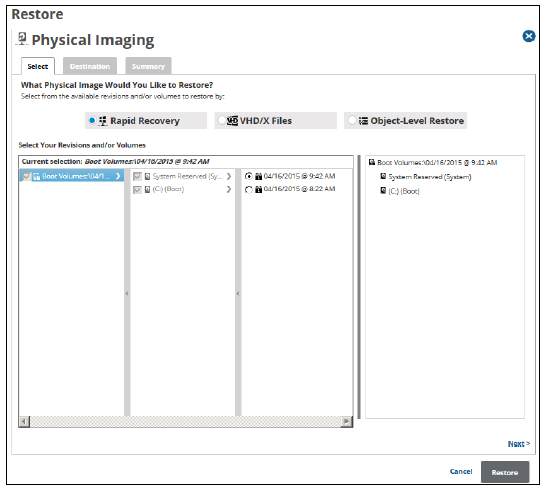
In the Current Selection pane, the boot volume is selected by default (it is grayed out). - Select any other volumes and revisions to be restored.
Clicking the arrow at the right of the items displays more files and folders.
at the right of the items displays more files and folders.
The selection is displayed in the far right pane. Click the remove icon to remove any selection.
icon to remove any selection.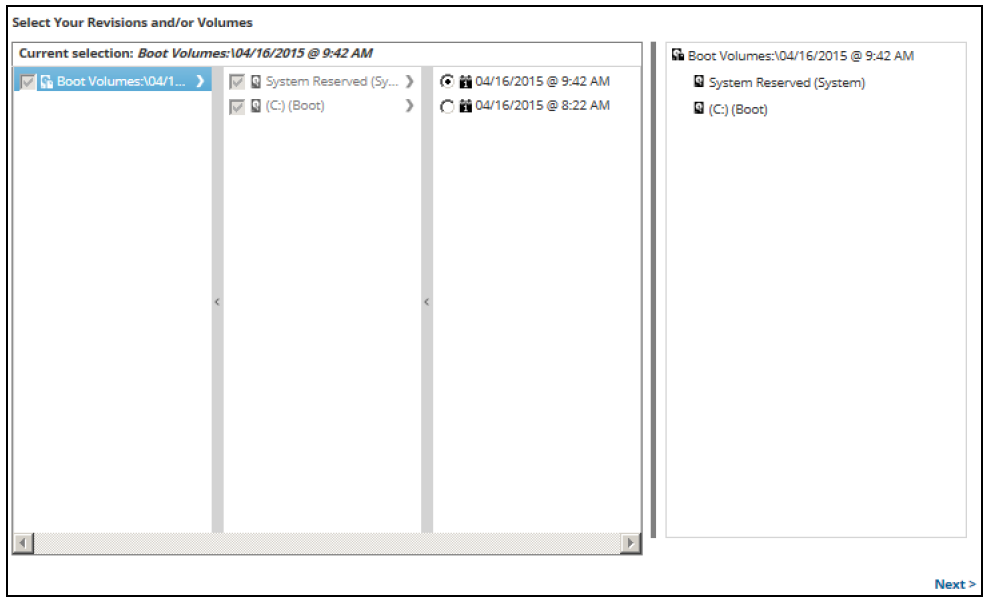
- After making your selections, click Next.
The Destination page is displayed.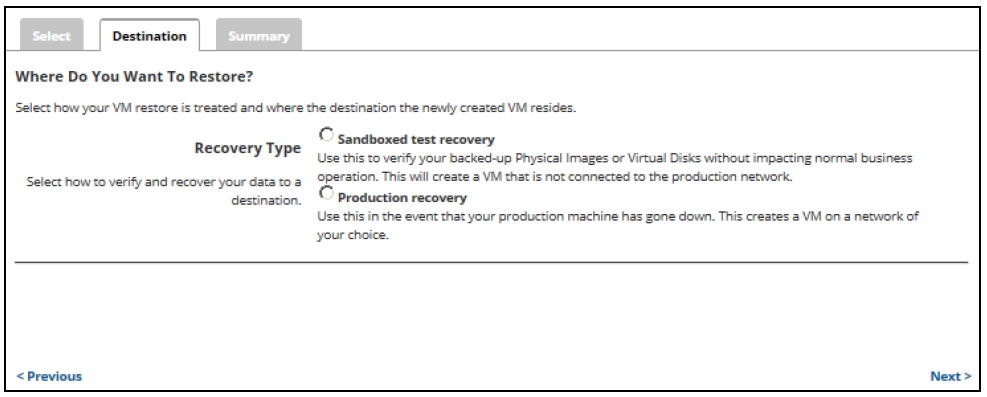
Notes:
- Use Sandboxed test recovery to verify your backed-up Physical Images or Virtual Disks without affecting normal business operation. This option creates a VM that is not connected to the production network. Sandboxed Test Recovery is a non-destructive means for you to verify the integrity of your backed-up images without affecting normal business operation. Your production images remain powered on and operational.
- Use Production recovery in the event that your production machine has gone down. Production Recovery performs a recovery of your production images with selected recovery images. - Select a Restore type radio button.
If you select Sandboxed test recovery:- The source/production images are not shut down.
- The recovery VMs created are started on their own separate VLAN to avoid conflicts with the production VMs.
- The source/production VMs are shut down.
- The recovery VMs selected are started on the production network. They assume the role of the original production machines.
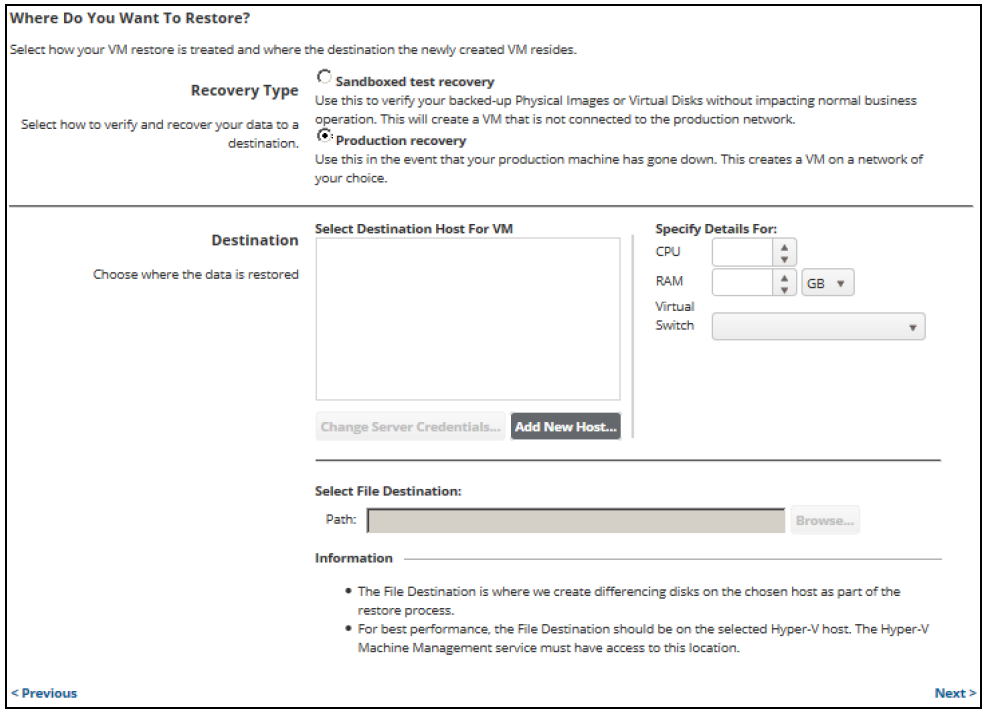
- At the Select Destination Host for VM pane, click the Add New Host button.
The Server IP Address pop-up is displayed.
- Type the IP address of the Hyper-V host, and then click OK.
The sign-in pop-up is displayed.
- Sign in, and then click OK.
- At the Specify details for Host VM panel, select the CPU and the RAM size.
- If you selected the Production Recovery option, select the Virtual Switch.
- At the Path field, type or browse to the destination of your restore.
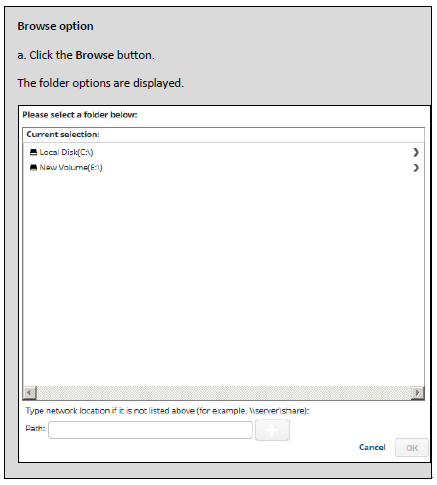
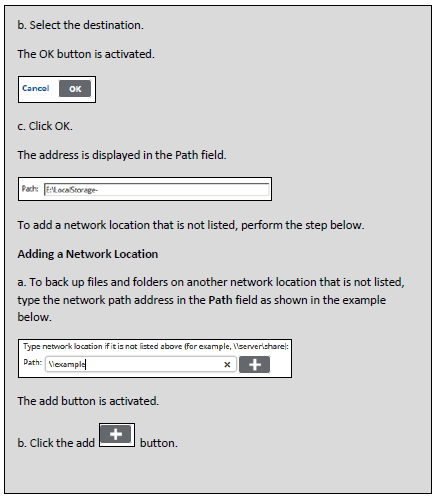
Notes:- The File Destination is where differencing disks are created on the selected host as part of the restore process.
- For best performance, set the File Destination on the selected Hyper-V host. The Hyper-V Machine Management service must have access to this location.
- If you select a remote host and the backup destination is a local non-shared folder, the following pop-up is displayed asking to share the backup destination. Canceling this pop-up deselects the remote host.

- After selecting the destination of your restore, click Next.
The Summary page is displayed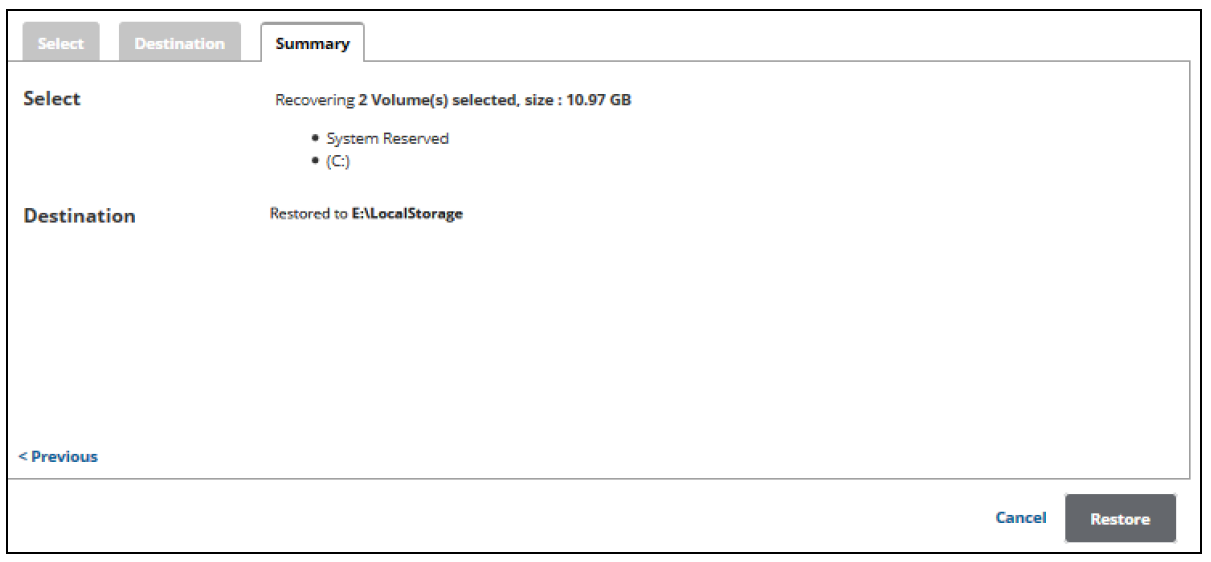
- Verify your selections, and then click the Restore button.
The confirmation pop-up is displayed.
- Click Yes.
The Restore Selections page is displayed with the status and a record is created in the Active Recovery tab
If the Manage Recovery action is not performed, you cannot run a backup/restore for the volumes that were restored using Rapid Recovery type.
